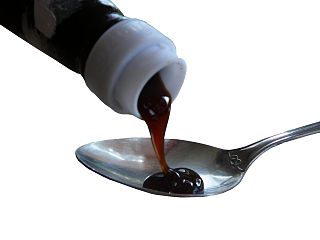A structural isomer, or constitutional isomer, is a type of isomer in which molecules with the same molecular formula have different bonding patterns and their atomic organisations, as opposed to stereoisomers, in which molecular bonds are always in the same order and only spatial arrangement differs. There are multiple synonyms for structural isomers.
Butanol (also called butyl alcohol) is a four-carbon alcohol with a formula of C4H9OH, which occurs in five isomeric structures (four structural isomers), from a straight-chain primary alcohol to a branched-chain tertiary alcohol; all are a butyl or isobutyl group linked to a hydroxyl group (sometimes represented as BuOH, n-BuOH, i-BuOH, and t-BuOH). These are n-butanol, 2 stereoisomers of sec-butanol, isobutanol and tert-butanol. Butanol is primarily used as a solvent, as an intermediate in chemical synthesis, and as a fuel. It is sometimes also called biobutanol when produced biologically and petrobutanol when produced from petroleum; those two names refer to the same substance, but highlight their different origins.
Cresols are organic compounds which are methylphenols. They are a widely occurring natural and manufactured group of aromatic organic compounds, which are categorized as phenols. Depending on the temperature, cresols can be solid or liquid because they have melting points not far from room temperature. Like other types of phenols, they are slowly oxidized by long exposure to air, and the impurities often give cresols a yellowish to brownish red tint. Cresols have an odor characteristic to that of other simple phenols, reminiscent to some of a "coal tar" smell. The name cresol reflects their structure, being phenols, and their traditional source, creosote.

Propylene oxide is an organic compound with the molecular formula CH3CHCH2O. This colourless volatile liquid with an odour resembling ether, is produced on a large scale industrially. Its major application is its use for the production of polyether polyols for use in making polyurethane plastics. It is a chiral epoxide, although it is commonly used as a racemic mixture.
In organic chemistry a halohydrin is a functional group in which a halogen and a hydroxyl are bonded to adjacent carbon atoms, which otherwise bear only hydrogen or hydrocarbyl groups. The term only applies to saturated motifs, as such compounds like 2-chlorophenol would not normally be considered halohydrins. Megatons of some chlorohydrins, e.g. propylene chlorohydrin, are produced annually as precursors to polymers.
The Controlled Drugs and Substances Act is Canada's federal drug control statute. Passed in 1996 under Prime Minister Jean Chrétien's government, it repeals the Narcotic Control Act and Parts III and IV of the Food and Drugs Act; and establishes eight Schedules of controlled substances and two Classes of precursors. It provides that "The Governor in Council may, by order, amend any of Schedules I to VIII by adding to them or deleting from them any item or portion of an item, where the Governor in Council deems the amendment to be necessary in the public interest."
There are two isomers of propanol.

1-Propanol is a primary alcohol with the formula CH
3CH
2CH
2OH. This colorless liquid is also known as propan-1-ol, 1-propyl alcohol, n-propyl alcohol, and n-propanol. It is an isomer of 2-propanol. It is formed naturally in small amounts during many fermentation processes and used as a solvent in the pharmaceutical industry, mainly for resins and cellulose esters.

Clortermine (Voranil) was developed by Ciba in the 1960s and is an anorectic drug of the amphetamine class. It is the 2-chloro analogue of the better known appetite suppressant phentermine, and is the 2-chloro positional isomer of chlorphentermine. Clortermine produces very low rates of self-administration in animals similarly to chlorphentermine, and as a result it likely does not act on dopamine. Instead, it may act as a serotonin and/or norepinephrine releasing agent.

In enzymology, a (R,R)-butanediol dehydrogenase (EC 1.1.1.4) is an enzyme that catalyzes the chemical reaction

p-Menthane-3,8-diol, also known as para-menthane-3,8-diol, PMD, or menthoglycol, is an organic compound classified as a diol and a terpinoid. It is colorless. Its name reflects the hydrocarbon backbone, which is that of p-menthane. A total of eight stereoisomers are possible, based on the three chiral atoms of the ring. Depending on the source, one or more may predominate.

3-MCPD (3-monochloropropane-1,2-diol or 3-chloropropane-1,2-diol) is an organic chemical compound with the formula HOCH2CH(OH)CH2Cl. It is a colorless liquid. It is a versatile multifunctional building block. The compound has attracted attention the most common member of chemical food contaminants known as chloropropanols. It is suspected to be carcinogenic in humans.
In chemistry, isomers are ions or molecules with identical formulas but distinct structures. Isomers do not necessarily share similar properties. Two main forms of isomerism are structural isomerism and stereoisomerism.

1,3-Difluoro-2-propanol is a metabolic poison which disrupts the citric acid cycle and is used as a rodenticide, similar to sodium fluoroacetate. It is the main ingredient in the rodenticide product Gliftor which was widely used in the former USSR.

2,2,4,4-Tetramethyl-1,3-cyclobutanediol (CBDO) is an aliphatic diol. This diol is produced as a mixture of cis- and trans-isomers, depending on the relative stereochemistry of the hydroxyl groups. It is used as a monomer for the synthesis of polymeric materials. CBDO is currently being researched as an alternative to bisphenol A (BPA). BPA is a precursor used in the production of a wide range of polymers including polycarbonates, polyesters, polysulfones, and polyester ketones.

Cyclohexane-1,2-diol is a chemical compound found in castoreum. It can exist in either cis- or trans-isomers.

Nadoxolol is an antiarrhythmic agent, chemically related in structure to beta-adrenergic receptor blocker drugs such as propranolol.

Oyster sauce describes a number of sauces made by cooking oysters. The most common in modern use is a viscous dark brown condiment made from oyster extracts, sugar, salt and water thickened with corn starch. Some versions may be darkened with caramel, though high-quality oyster sauce is naturally dark. It is commonly used in Cantonese, Thai, Malay, Vietnamese and Khmer cuisine.

1,3-Dichloropropan-2-ol (1,3-DCP) is a organic compound with the formula HOCH2CHClCH2Cl. It is a colorless liquid. It is an intermediate in the production of epichlorohydrin.

Pregnanediol glucuronide, or 5β-pregnane-3α,20α-diol 3α-glucuronide, is the major metabolite of progesterone and the C3α glucuronide conjugate of pregnanediol (5β-pregnane-3α,20α-diol). Approximately 15 to 30% of a parenteral dose of progesterone is metabolized into pregnanediol glucuronide. While this specific isomer is referred to as pregnanediol glucuronide and is the most major form, there are actually many possible isomers of the metabolite.












